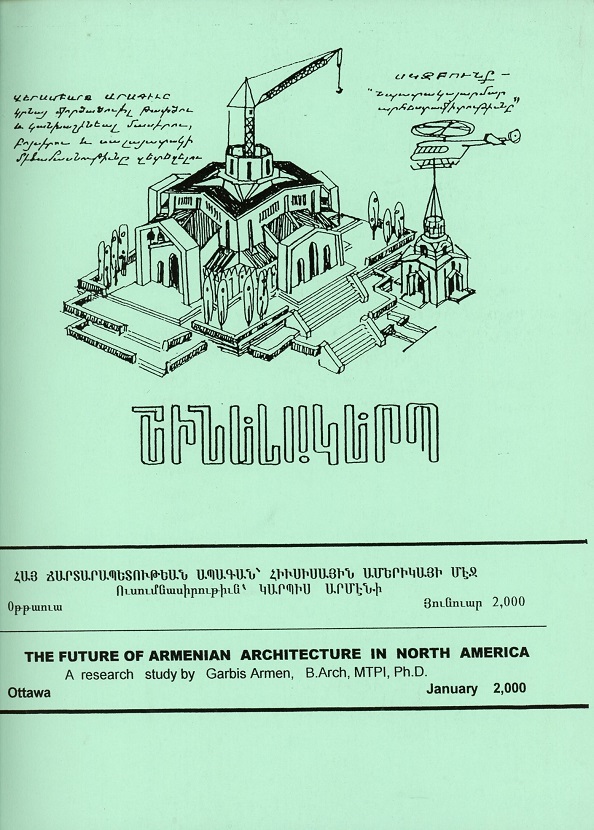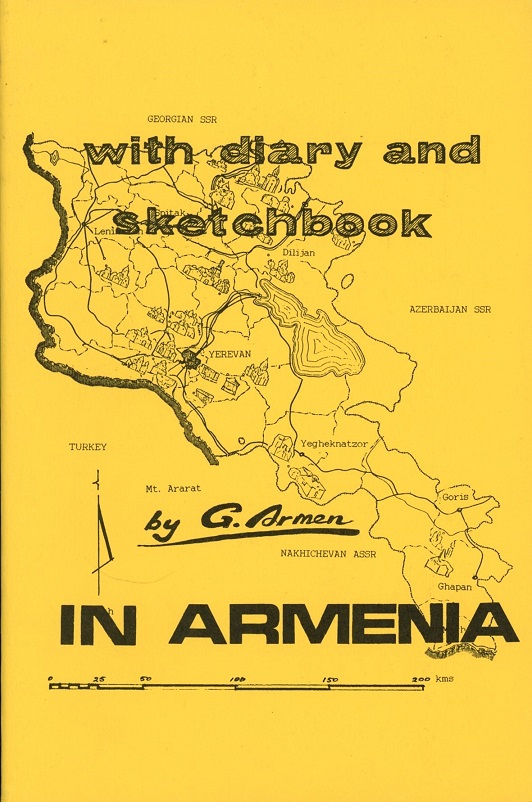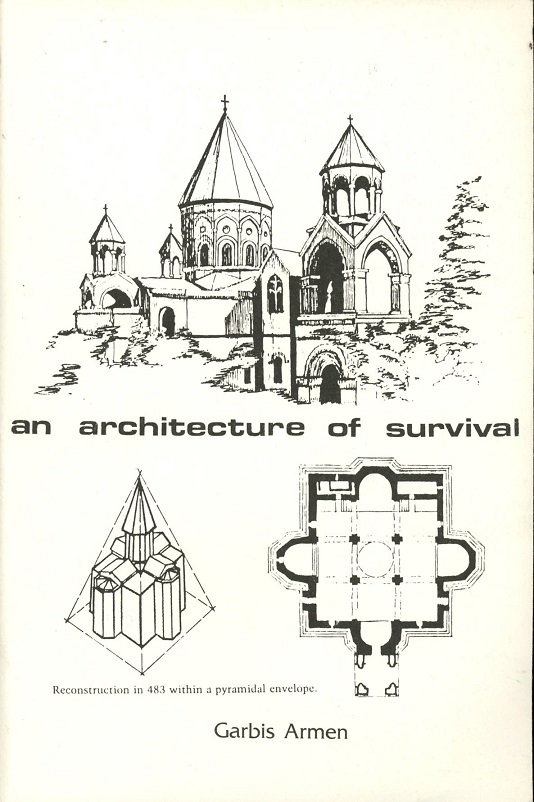
451 Rangement général
 | | Nationality: Stateless ; Origin: Armenian |
| Titre : | Nationality: Stateless ; Origin: Armenian / auteur(s) : Garbis ARMEN - Anatomy of a cause through a series of short stories |
|---|
| Editeur : | Garbis Armen |
|---|
| Année : | 2004 |
|---|
| Imprimeur/Fabricant : | Ottawa |
|---|
| Description : | 21,5 x 27,5 cm, 174 pages, couverture illustrée |
|---|
| Collection : | |
|---|
| Notes : | |
|---|
| Autres auteurs : | |
|---|
| Sujets : | |
|---|
| ISBN : | 0969590040 |
|---|
| Lecture On-line : | non disponible |
|---|
Commentaire : |
455 Rangement général
 | | The future of the Armenian architecture in North America |
| Titre : | The future of the Armenian architecture in North America / auteur(s) : Garbis ARMEN - |
|---|
| Editeur : | Garbis Armen |
|---|
| Année : | 2000 |
|---|
| Imprimeur/Fabricant : | Ottawa |
|---|
| Description : | 21 x 27 cm, 94 pages, couverture illustrée, polycopié, nombreuses illustrations et photos |
|---|
| Collection : | |
|---|
| Notes : | |
|---|
| Autres auteurs : | |
|---|
| Sujets : | Architecture moderne |
|---|
| ISBN : | |
|---|
| Lecture On-line : | non disponible |
|---|
Commentaire :After a 70-year hiatus in the development of the Armenian national architectural style due to an atheistic Soviet regime, where is the place offering the greatest opportunity to develop this style into the world of today ? The author believes that with a community of nearly a million Armenians, determined to maintain and develop their national culture - in which architecture holds the proudest position - technologically advanced North America is the most likely place. For any given project, he sets out a process of looking at: (a) long term trends in the Armenian traditional style; (b) related symbols and structures which offer scope for novel design concepts through abstraction; and (c) the most appropriate current building technology. Considered in a synergetic manner, these factors could help Armenian architects in USA and Canada, to develop an innovative Armenian architectural style. He offers no magic solutions, firmly believing that "The style depends on the materials, the times, the subject and the Man". ( P. V. Jensen-Klint)
INTRODUCTION AND EXECUTIVE SUMMARY
Any culture with strong architectural traditions - like the Armenian style of church architecture - if transplanted to a progressive technological new environment - like North America - could be expected to bear some influences and evolve more rapidly than in its original milieu - the country in which the architectural traditions were established a long time ago - i.e. Armenia.
Starting with this hypothesis, this study has found that over a century of development in North America, the Armenian style of church architecture has changed little in terms of building forms - the traditional pitched roof, dome and central hall - but much in terms of materials used to create these forms - timber and metal for the roof, concrete for the dome and steel or reinforced concrete frame for the hall. In other words, the technology has been made subservient to traditional Armenian building forms.
Many Armenians would feel proud of this, as the traditional style imitated by many of these churches re-asserted the national identity and indomitable will to survive, after the horrendous 1894-1923 genocide by the Turks. The fact remains however, that no benefit has been derived from the use of new materials to develop new forms and develop the traditional style into the 21st century. A rigidity has set in, which stifles the young generation and does not show Armenian architecture as a live, contemporary style, able to respond to current community needs and trends and meet them with current materials, building organization methods and technology.
The objective of this study is to provide a springboard for the development of new forms in Armenian architecture, by taking due account of the technology of this continent on one hand and recognizing the potential for symbolism and abstraction inherent in traditional Armenian building forms on the other. A natural step in the development of any traditional architecture in this new technological environment - Armenian, Byzantine or Gothic - would be an abstraction of traditional forms, towards shapes and concepts which take due account of the potential offered by new materials - concrete, aluminum, etc - techniques like prefabrication and use of cranes - and novel organizational methods - like variable price contract - which are available in this progressive environment. Abstracting the traditional is therefore an essential step to develop new forms and maintain the national identity of modern Armenian churches.
In the chapters, pages and particularly diagrams that follow, an attempt has been made to substantiate the above, in order to project an exciting future for Armenian architecture.
ACKNOWLEDGEMENT
The author is grateful to Prof. Isabel Kaprielian of the Armenian Studies Department of the University of California in Fresno, for suggesting a study on Armenian churches in North America. The study was carried out and this report was published without any financial assistance - hence the high cost of each copy.
The author remains solely responsible for all shortcomings due to limited finance and manpower and consequent limitations in the scope of this exciting subject. It is hoped that the report will inspire architects, to develop this subject to its full potential. |
449 Rangement général
 | | In Armenia |
| Titre : | In Armenia / auteur(s) : Garbis ARMEN - With diary and sketchbook |
|---|
| Editeur : | Garbis Armen |
|---|
| Année : | 1993 |
|---|
| Imprimeur/Fabricant : | |
|---|
| Description : | 15 x 23 cm, 222 pages, couverture illustrée |
|---|
| Collection : | |
|---|
| Notes : | |
|---|
| Autres auteurs : | |
|---|
| Sujets : | |
|---|
| ISBN : | 0969590032 |
|---|
| Lecture On-line : | non disponible |
|---|
Commentaire :The name ARMENIA does not often appear in the press and most people can only recall sad, even tragic facts about this country. The idea of visiting it as a place for a pleasant holiday, does not occur lo many people in the world today. Readers of this book, however, will find many a new reason for a journey to Armenia: the enormous variety she offers in terms of unusual landscape sights and tremendous scenery, friendly people, traditional villages and folklore, ancient monuments of architec-tural, structural, as well as historical interest and above all, an unusual, intriguing, original and amazing range of stories: stories related to people - famous or infamous - to places and sights. Some of these stories are tinged with sadness, but most of them are witty and humorous, many, are simply hilarious ! "Having travelled widely over the last 30 years, there is no doubt in my mind that if a traveller is looking for the unusual, for contrast, colour, natural and man-made beauty; for the funny as well as the tragic in human experience; for the ancient as well as the daring in man-made structure, then, few other countries can offer it in such a high density and variety, as Armenia". |
438 Rangement général
 | | An architecture of survival |
| Titre : | An architecture of survival / auteur(s) : Garbis ARMEN - |
|---|
| Editeur : | Garbis Armen |
|---|
| Année : | 1992 |
|---|
| Imprimeur/Fabricant : | Hairenik Association |
|---|
| Description : | 15,5 x 23 cm, 244 pages, couverture illustrée NB |
|---|
| Collection : | |
|---|
| Notes : | reprise d'articles précédemment parus dans "The Armenian Review" |
|---|
| Autres auteurs : | |
|---|
| Sujets : | |
|---|
| ISBN : | 0969598808 |
|---|
| Lecture On-line : | non disponible |
|---|
Commentaire :The author's definition of an "architecture of survival" is a style of defensive design and construction which results in weather-proof, vandal-proof, quake-proof and explosion-proof buildings. In this collection of articles published between 1983 and 1990, he traces the development of structural innovations to combat earthquake movement, vandalism and weathering from ancient times and reviews an early 20th century theory as to how they were diffused to the West. As a practicing architect, he believes that the principles underlying this 4,500-year long tradition in defensive design are still applicable and can lead not only to safer, but also more unique buildings in the world today. |
|





